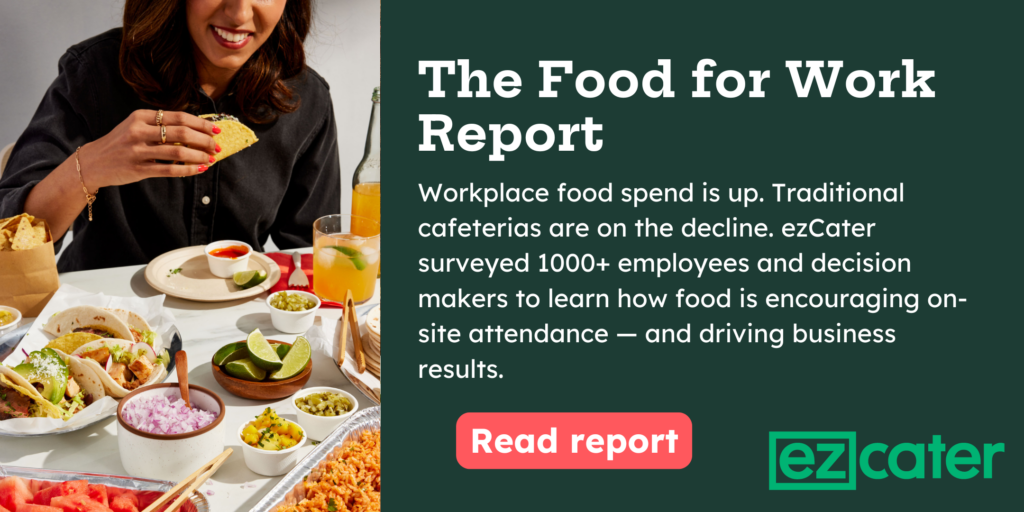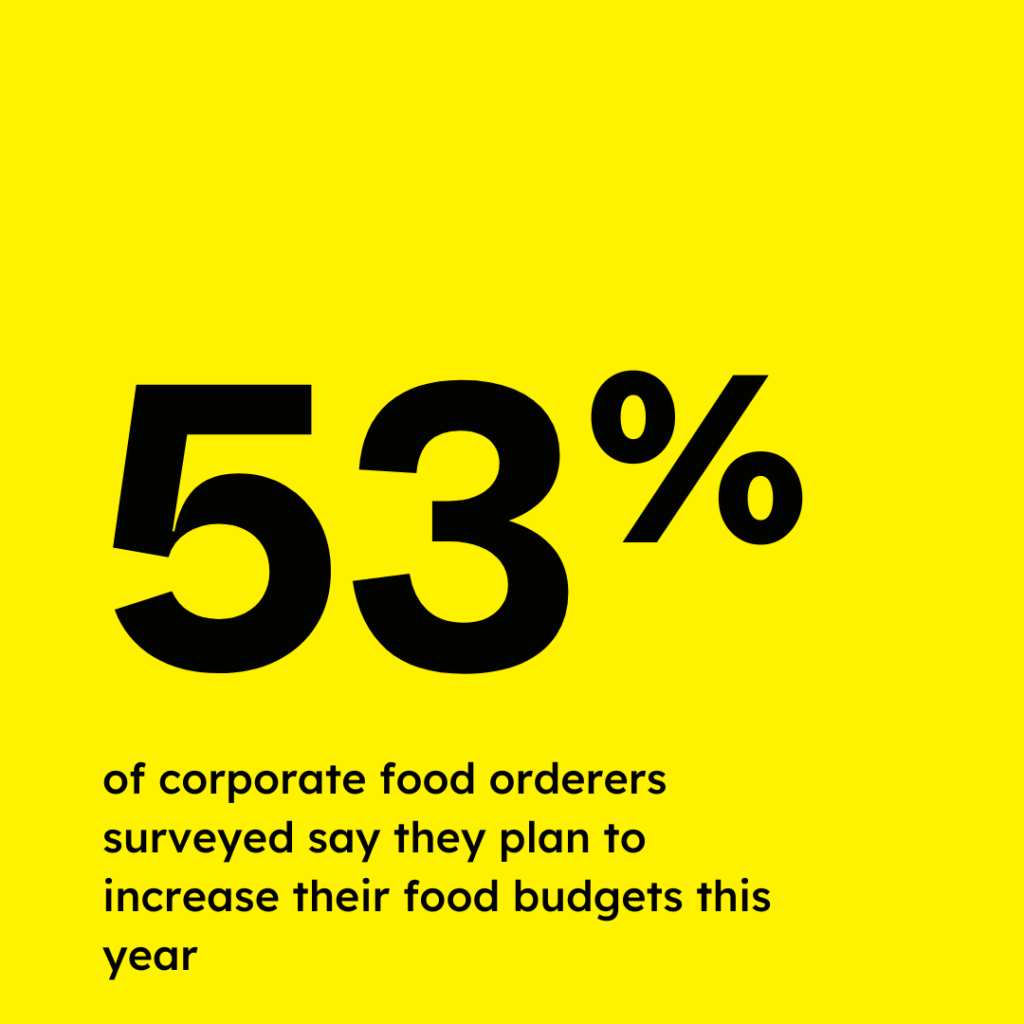Survey says: Workplace catering is trending up in 2024, with changes ahead
- Beth Deyo
- •
- 3 Min Read
- •
As more employees report on-site for work, forward-thinking leaders are looking for ways to enhance the workplace experience. One common strategy? Focusing on employee well-being, satisfaction, and retention — and offering meaningful perks that resonate with today’s workforce.
Free food has long been a top-ranking perk among employees. In 2024, it’s even more important. Today, workplace meals are taking center stage as companies ramp up their food spend, recognizing that a well-fed team is a productive team.
To understand the continuing evolution of food in the modern workplace, ezCater surveyed employees, food orderers, and key decision-makers, then compiled the results in the 2024 Food for Work Report.

The report reveals critical trends, highlights the benefits of offering free or subsidized food in the workplace, and makes it clear that on-site food is no longer a “nice-to-have” work perk. Instead, it’s a key benefit that’s essential for driving employee satisfaction.
But simply offering food isn’t enough. Survey results suggest that traditional food options may no longer meet employees’ changing needs. As once-beloved food models lose favor, new ones are taking shape. Flexible, personalized solutions might just change the food-for-work model forever. Let’s take a deeper dive into the latest data and insights for clues into what’s next.
Employer food spend is up in 2024
One of the biggest takeaways from the Food for Work Report is that companies are spending more money feeding the workforce. More than half (53%) of corporate food orderers surveyed say they plan to increase their food budgets this year.

At first, this may seem surprising, but it fits into a larger picture of evolving workplaces. In 2024, more employees are clocking in on-site, with 90% of surveyed workers saying they spend at least two days a week at the office.It’s a big change from just a few years ago, when fully-remote schedules were the norm across several industries.
Higher on-site attendance means more mouths to feed and larger food orders — but there’s more to it than that. Employers are also looking for ways to keep their teams motivated and engaged. Free or subsidized meals are proving to be a powerful incentive, with nearly 90% of surveyed employees agreeing food makes them feel more positively about their company.
Companies are getting creative with food budgets
Traditionally, corporate cafeterias were the answer to a hungry workforce. But that’s evolving too. Today, nearly two-thirds of decision-makers are open to leaving cafeterias behind due to high operating costs, changing employee appetites, and logistical challenges posed by fluctuating headcounts.
Interestingly, the 2024 Food for Work Report highlights that both businesses and employees are eager for a change. Workers are craving more variety and flexibility in their food options. As a result, businesses are turning to more adaptable solutions — like recurring employee meal programs.
It’s a welcome shift: the 2024 Food for Work Report uncovered that 71% of employees prefer to make their own food choices when it comes to employer-provided meals. Services like Relish by ezCater streamline the process. Companies can set a budget and put employees in charge of ordering their own meals, ensuring everyone gets what they want without the hassle (and expense) of managing a cafeteria. This creates a win-win situation: employees enjoy the foods they crave, while employers keep their food spending in check.

Modern food-for-work solutions drive business results
The 2024 Food for Work Report confirms that food for work is one of the most effective workplace perks. Not only are employer-provided meals popular among employees, they may offer a better return on investment (ROI) compared to other perks, like wellness benefits or employee education. Here’s how.
Employer-provided food promotes on-site attendance
Getting employees to come into the office can be a challenge, but the benefits of in-person collaboration can’t be overstated. With one in four business leaders planning to increase in-office days for their teams in 2025, many companies are using food as a way to boost attendance rates.
Survey data shows this strategy can work. Eighty-eight percent of business leaders say that providing meals encourages more employees to work on-site. And 67% of hybrid employees agree, stating that free meals make the office more appealing.

Employee food perks attract top talent
In a competitive job market, employer-sponsored food can give organizations a significant edge. Employees value perks that make their workday more enjoyable, and free meals are near the top of the list. Informing job seekers about this benefit from the start can make them more interested in applying, interviewing, and accepting an offer.
Savvy company recruiters aren’t missing this opportunity. In 2024, 59% of surveyed corporate orderers say they mention subsidized meals on job listings and career pages — 45% even mention free coffee or snacks.

Catered meals help retain valued employees
Happy, well-fed employees are more likely to stay at their company, reducing turnover costs. At a time when 46% of professionals say they’re thinking of quitting their jobs, organizations need to leverage every advantage they can get to retain top talent. Providing free or subsidized food is one of the best ways to do this. According to Food for Work Report data, 78% of food orderers say it’s a perk that makes employees more likely to stay.

Read the 2024 Food for Work Report
When it comes to employee perks, there are few options that offer as many benefits as workplace meals. From driving on-site attendance to retaining top talent, modern food-for-work solutions have the potential to give companies a strategic edge.
Want to learn more? Download the full 2024 Food for Work Report to take an in-depth look at its findings and see how partnering with ezCater can set your business up for success.








